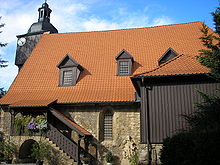BWV 196
|
Der Herr denket an uns BWV 196 |
|
|---|---|
| Church cantata by J. S. Bach | |

The church in Dornheim, where the cantata may have been performed
|
|
| Movements | 5 |
| Bible text | |
| Vocal |
|
| Instrumental | strings and continuo |
Der Herr denket an uns (The Lord is mindful of us),BWV 196, is a cantata by Johann Sebastian Bach. The early church cantata, possibly for a wedding, is difficult to date, but is generally considered to be an early work on stylistic grounds. The text is a passage from Psalm 115, assuring of God's blessing, especially for children. Scholars have suggested the work may have been written for the wedding of Johann Lorenz Stauber, the minister in Dornheim who had married Bach and his first wife there in 1707, and Regina Wedemann, an aunt of Bach's wife, on 5 June 1708.
Bach structured the work in five movements – an instrumental Sinfonia, a chorus, an aria, a duet and a final chorus. He scored it for three vocal soloists, a four-part choir and a Baroque instrumental ensemble of strings and continuo.
The precise date of composition for this cantata is unknown, but it is generally considered to be an early work. The English Bach scholar Richard Jones notes that "although it survives only in a later manuscript copy", its stylistic features are evidence of an earlier date: its text comprises "selected psalm verses only, without any free madrigalian verse", it has no recitative, and the compositional approach "still breathes the air of the seventeenth century".
Many of Bach's later church cantatas were composed for the requirements of the liturgical calendar, but the early ones, including Der Herr denket an uns, were written for special occasions. The text is taken from , speaking of a thoughtful and blessing God. The passage includes in verse 14: "The Lord shall increase you more and more, you and your children". Many commentators, from his biographer Philipp Spitta onwards, have concluded that the cantata was written for a wedding. They have proposed weddings where it might have been performed, including Bach's own in October 1707, when he married his first wife Maria Barbara in Dornheim. The Bach scholar Alfred Dürr and others suggest that the cantata may have been written for the wedding of the minister Johann Lorenz Stauber, who had conducted the wedding ceremony for Bach, and Regina Wedemann, an aunt of Maria Barbara, in Dornheim on 5 June 1708. However, the wedding hypothesis is not proven, and the general text could fit other occasions.
...
Wikipedia
